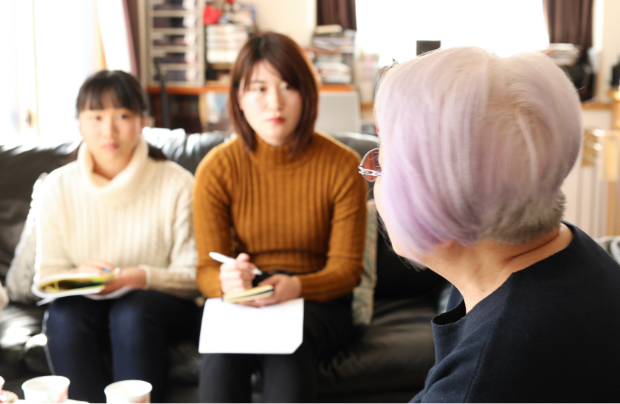HIROSHIMA memory keepers Pass down a story
Vol. 16 2019.7.18 up
When I help a pregnant mother deliver a baby on August 6, I say to her, “If you don’t mind, would you offer a silent prayer with me?”
Miwako Kanbe
In Tokyo A-bomb survivor
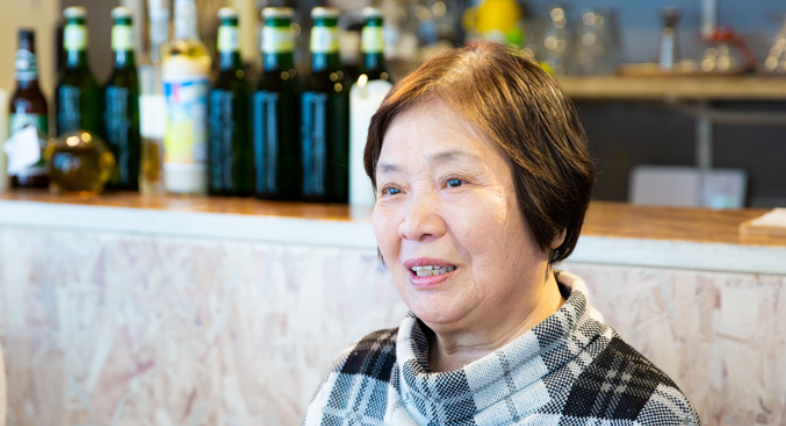
What do people handing down the experience of the A-bombing think and try to convey?
“Hiroshima – 3rd Generation Exhibition: Succeeding to History” will be held at Machida City Life Learning Center in Tokyo in 2019.
We asked Miwako Kanbe, an A-bomb survivor (81), who lives in Machida City, about what had happened on August 6 and what Hiroshima was like before and after the war.
Section
- How Hiroshima was during the war
- On August 6
- What Hiroshima was like after the A-bombing.
- My resolution to be a midwife at the age of seven
- My brother’s bride who had keloid scars on half her face
- Discrimination I faced in the junior high school in Okayama
- A promise with my brother’s wife – Testimony I made forty years after the war
- Handing down the A-bomb experiences to the next generation
How Hiroshima was during the war
Ms. Kanbe, you were born in Hiroshima. How long have you lived in Machida City?

I have lived in Machida since 1962. When I moved to Machida, housing complexes began to appear. So it is more than fifty years ago.
How old were you when you were exposed to the A-bombing in Hiroshima?

I was seven years old. I was a second grader of a national elementary school. Third graders and above evacuated to the countryside. I remember that I was looking forward to the school evacuation the next year. I felt it would be like going on an excursion.
Where did you live in Hiroshima?

I lived in Shinonome.
How many members were in your family?
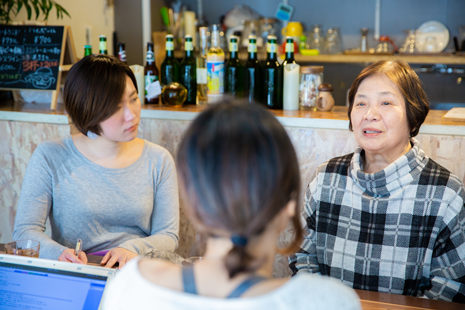
We were Mother, two elder brothers far apart in age, and me. Totally four members. My father died of acute pneumonia when I was four years old. My eldest brother was 19 years older than me, and the second brother was 17 years older. I was the youngest. My eldest brother had already gone to Manchuria as a soldier with the Kwantung Army. My second brother went off to the war in March, 1945. Do you know the meaning of “Go off to the war”? He became a soldier to go to war.
I remember my mother saying,“Tomorrow, we’ll go to Hiroshima Station to see off your brother.You must not shed tears when you say “good-bye” to him.Tears are ominous.” On that day, soldiers who were going to the front marched to Hiroshima Station. My brother joined the march at Taisho Bridge near my house. When I saw my brother smiling at me, tears began to fall down from my eyes. I was thinking, “This might be the last time to see him.” My mother pinched my arm sharply and said angrily, “Don’t cry.”
I didn’t know that when they headed for the front, they marched to the station.
Yes. People who were watching them marching called, “Hurray! Hurray!” to them again and again, waving the rising sun flags. People saw them off singing martial songs. The new soldiers saluted when their names were called by the senior officer, then joined the line and began to walk away. Many soldiers left Hiroshima by train, so Hiroshima Station was very crowded Some women were also among those who went to the front. They were nurses who wore navy blue hats and uniforms and black shoes. A girl about three years old was led by an old lady, seeing her mother off. During the wartime, people left their small children behind to go to the front and dedicated their lives to Emperor.
What was Hiroshima like before the A-bombing?

Hiroshima had not been bombed. That was why we were unsuspecting. My mother and other neighbors said, “Hiroshima is a city of soldiers, so even though other cities are bombed, Hiroshima won’t be touched,” We were told that Americans and English people were satanic animals. I believed that Japan would surely win because divine wind would blow. One day, I went all the way to Hachobori to see the place where a bomb had been dropped.
Do you mean that seeing a dropped bomb was unusual?

Yes. A big hole was open. I was surprised to see how a bomb could cause such a big hole.
You mean Hiroshima had not been bombed so much before the A-bomb?

That’s right. Even though an air-raid warning sounded, it was called off soon. Before the A-bomb, I saw a B-29 from Taisho Bridge. Then, a woman I didn’t know said to me, “Hide quickly. A B-29 is coming.” However, I just wondered what a B-29 was.
Didn’t you learn about B-29s at school?

I don’t have clear memories about it. I just remember that when we drew flowers, those paintings were not put up in the classroom, but when we drew airplanes or soldiers with the words “Hurrah for the soldiers!” they were displayed. Children like their works to be put up, right? The teacher often told us to draw soldiers the next time.
On August 6
According to what you just told me, didn’t you really feel the situation was serious?
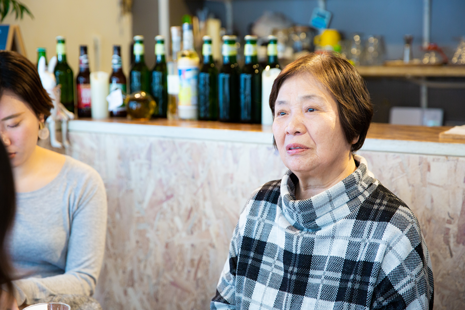
No. I don’t know about others, at least I didn’t. I was exposed to the A-bombing at home in Shinonome, 3.8km from the hypocenter. I was in the wooden passageway on the east side in my house, playing with cards called “a game of family matching.” Wearing work pants and a big straw hat, my mother had gone to help with a nearby vineyard.
In the morning, I saw Hiroko, a girl who lived in the house next to us, going to a girls’ commercial school, carrying a hoe on her shoulder. You may think it strange to carry a hoe on your shoulder to go to school. In those days, we didn’t study at school. Instead, we did labor service. I said to her, “Have a good day!”, and then she answered, “Thank you!” That was the last I saw her. She never returned. Kyoko, Hiroko’s four-year-old sister, was visiting me to play together.
Didn’t you go to school on August 6?

On that day, school was divided into morning class and afternoon class, and I was going to attend the afternoon class at a temple. When the A-bomb was dropped, a red-purple flash came from above my head covering my whole body. Then the blast came. With an enormous BOOM! I screamed, and at the same time, shattered pieces of glass blew at me and stuck all over my body.
Did you face the blast directly?
Yes. I wore a dress which was called “a simple dress” in those days. My exposed skin outside of the dress was stuck with glass fragments. I lost consciousness for a while. I came to when my mother shook me strongly, shouting. “Wake up! Are you OK?”
I became worried about Kyoko who was in our house to play together and asked, “Mother, is Kyoko OK?” Then, I saw her standing in a small space under the broken pillar in the kitchen.
Was she standing?

The house was messy inside by the blast. But Kyoko was standing (laugh), just standing absent-mindedly, unhurt. She was unhurt at that time but later developed acute disorders due to radiation about one week later. Purple spots appeared and she lost much of her hair.
What did you do with the fragments of stuck glass?

My mother pulled out the big ones by hand. We had only mercurochrome at home, so I couldn’t receive enough treatment. In those days, everyone, adults and children, carried their first-aid bags with them.
What was inside the bag?

There were mercurochrome, bandages made of torn shirts, and so on.
Using the bandage in the first-aid bag, my mother rolled up my body like a mummy.
When we went out of the house, we saw a huge, black smoke pillar climbing into the sky. It climbed up and up.
Its top became round and it came to be that atomic cloud.
It was the well-known mushroom cloud, wasn’t it?

Yes, it was. I asked my mother what it was. She answered, “It is terrible. I heard that a gas tank had exploded.” Who could have imagined that an A-bomb was dropped? Some neighbors said, “Hiroshima is filled with poisonous gas, so women and children must not enter the city.”
What Hiroshima was like after the A-bombing.
Did you develop any A-bomb diseases?

Yes. I gradually became sick. I lost my hair and felt exhausted.
I always said to my mother, "Mother, I'm so tired. I’m so tired.”
My mother believed that it was important to feed me as much as possible to make me healthy, so she cooked summer vegetables and potatoes from our garden.
There was a big river called Enko River near my house.
My mother picked up clams at the ebb tide, took oysters away from the rocks, or got small fish for me.
After the A-bombing, didn’t radiation affect you?

I should not have got healthy by eating radioactive food.
Whenever my mother remembered those days, she apologized to me, saying “I’m so sorry.
I was wrong. I was so desperate to save you that I forced you to eat what was contaminated by radiation, though you were unwilling to eat.”
Did you enter the city center after the A-bombing?
Yes. One week after the A-bomb was dropped, I entered the city center with my mother to look for our friends living in Ushita.。
We passed in front of Hiroshima Station and walked to Ushita. Everything was burned flat and nothing was left.
Before the A-bombing, I could see Fukuya Department Store in the distance, but at that time I could see it clearly in front of me.
I observed strange scenes. Streetcars and metal bathtubs were lying around.
Water was spurting out here and there.
My mother pointed at something like a piece of cloth and said, “Look at that.”
I looked at it carefully. It was a body, and I cried out.
I heard that there were really many dead bodies lying in the city after the A-bombing.

Hiroshima Higher Normal School was 4km from the hypocenter.
On the riverbed near the school, soldiers dug a big hole and cremated bodies collected from all over the city.
Do you know a cart called Daihatchiguruma?
Is it like a two-wheeled cart?
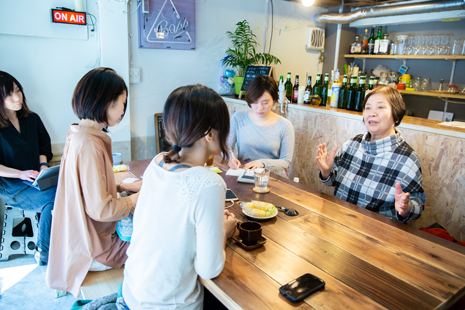
Yes. It is a cart with two big wheels so that people can pull.
Around 8:00 a.m., soldiers loaded piles of bodies on a two-wheeled cart and tied the bodies with a thick straw rope. They pulled the carts creakily.
We children climbed up the river bank and watched from there.
Among the bodies, we saw the legs of a tall body swinging. At first, we were frightened, but gradually became accustomed to seeing such scenes.
Children were so dreadful that we counted unashamedly the number of the carts we saw each day.
“Today, we saw…carts.”
Maggots were breeding on the bodies waiting for cremation. The next morning, those bodies were covered with black flies. We ran toward those dead bodies with wooden slippers on, and jumped over them.
We enjoyed seeing the surprised flies flying off all together into the air.
My resolution to be a midwife at the age of seven
About two days after the A-bombing, two small rice balls were rationed per person.
They were not like the ones we can buy at a present-day convenience store.
They were so small that I could hold them in my palm. In those days, we called cooked white rice “silver rice.”
When my mother came home with four rationed rice balls on a lid of a pan, she said,“Yesterday, a baby was born in the post office basement filled with dead bodies. I heard that it was a girl and she gave a healthy first cry. There’s nothing that could make me happier than this.”
She went on, “A midwife crawled out of the dead people and she helped her deliver the baby, saying, ‘I’ll do this.’ The midwife was great. When you grow up, you should be a person who is helpful to others.”
Hearing what she said, I determined to be a midwife in the future.
It might be too exaggerated to say that I resolved my future at the age of seven, but I chose my career because of this incident.
My brother’s bride who had keloid scars on half her face
My second brother, who had been deployed in Yamaguchi, returned home at the end of the year.
When I was a fifth grader, he announced, “I plan to get married. I’ll bring my girlfriend tomorrow.”
The next day he brought the girl whose face had keloid scars on half of it.
After the war mothers warned their sons when they went to Hiroshima on business.
They said, “You should not date with a girl who wears a long-sleeved shirt in summer. Long sleeves can hide keloids. You must not marry such a girl.”
As we didn’t expect any of our family to marry a girl with keloid scars, all the relatives opposed their marriage strongly.
However, in spite of their opposition, my brother didn’t give in and married the girl.
His wife was exposed to the A-bombing when she was 21, working in a munitions factory in Takaya-cho, 700 m from the hypocenter.
She told us that she had been carried to a place like a gymnasium with her 15-year old sister and laid on a straw mat.
Even when her father came to look for them and called their names, she couldn’t move her mouth because of serious burns. Her sister died in the early morning of August 9.
Discrimination I faced in the junior high school in Okayama
When I was a sixth grader, my brother, his wife, my mother and I moved to Takahashi in Okayama Prefecture, my mother’s hometown.
However, as local people became curious about my brother’s wife’s keloid scars, they returned to Hiroshima soon.
When I was a first year student of junior high school, the Korean War began.
I worried whether an A-bomb would be used again in the war.
I asked my homeroom teacher, “Will an A-bomb be used in this war again?
I was exposed to the A-bombing in Hiroshima. If we speak out to stop the war, can we stop the war?”
The teacher was a war veteran. I had lost my father, so he was like my father to me.
He answered, “No one knows if an A-bomb will be used again.
Even if you speak out, we cannot stop the war.”
Hearing his answer, I became so impatient. I said to my teacher, “May I talk to the class about the A-bombing?”
Many people hide their A-bomb experiences after the war, but you talked about your story. I am surprised.

Yes. I seriously thought that if I told my classmates how horrible the A-bomb was, and if everyone protested against the war, we could avoid the use of the A-bomb.
Then, during homeroom, I talked about my A-bomb experience and how horrible the A-bomb was.
What were your classmates’ reactions?
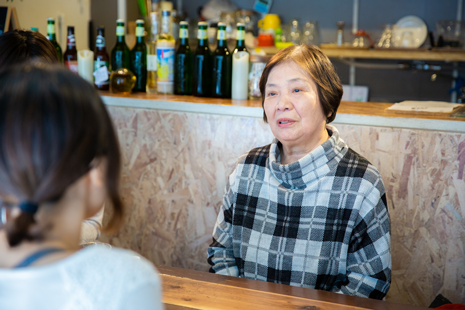
Just after my talk, some students asked me the cont-ttl-qs like, “What happened when the A-bomb exploded?”
However, on the following days, my friends suddenly disappeared around me. When I walked, people around me darted away.
I had a friend named Tomo-chan whose parents ran a kimono shop.
She was a fair, small and pretty girl. I liked her very much. She called me Mi-chan and we played together.
However, after my talk, she ran away when I spoke to her.
I grabbed her by the hand and pulled her under a tree.
I asked her, “Why am I hated by others?” Crying and looking frightened, she answered, “You said that you had been exposed to the atomic bomb, didn’t you? Someone’s mother said that radiation would be infected from your hand and kill people you touched. So, I wanted to keep away from you.”
When I heard this, I ran back home with tears and told my mother about that.
She listened to me seriously and said, “People and soldiers who rescued the victims after the A-bombing have been dying due to residual radiation. As the radios and the newspapers report these things every day, everyone has anxiety. You must not tell anyone about your experiences. We don’t have keloid scars, so if we keep silent, no one will know. You must not tell others that you are an A-bomb survivor.”
I made a pinky promise that I would not tell anyone about the A-bombing.
Since then, for forty years, I had never told anyone that I am an A-bomb survivor.
A promise with my brother’s wife – Testimony I made forty years after the war
What made you tell your A-bomb experience forty years after the war?

That year, an assembly for mothers from all over Japan was held at Meiji University in Tokyo. I participated in one of the subcommittees whose title was “Handing Down the War Experiences.”
One person on the stage talked about her evacuation from Manchuria, and another talked about her war experience in Hokkaido.
Other people told the stories of their own war experiences.
When the chairperson asked, “Is there anyone else who wants to speak?” I raised my hand.
Did you want to talk about your story after hearing other people talking about their war experiences?

In a way, yes. However, it was due to my promise to my brother’s wife.
What kind of promise was it?
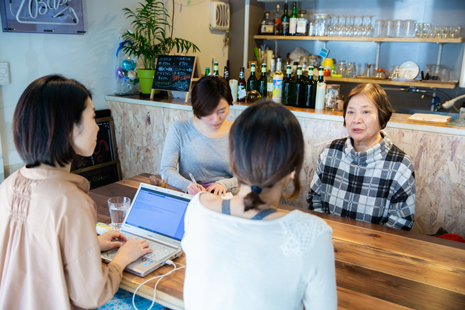
My brother’s wife who had been inflicted with keloid scars died young of uterine cancer at the age of 40.
A few days before her death, I visited her at the hospital with my son.
She looked in pain with her belly full of abdominal swelling.
She saw my child and asked, “Do you love your child?” I answered, “Of course! This is my son. I love him.”
Then, she said, “Don’t let the A-bomb kill this child.
I heard that there are still many nuclear weapons in the world. We don’t know where and when they will be used. Why don’t you raise your voice?”
I answered, “I won’t tell about the A-bombing because I don’t want my child to be discriminated like I used to be. Then she began to take off her dress, saying, “Don’t think only about yourself. Make people know about how horrible the A-bomb was. Take pictures of the keloids on my body and show them.”
Hastily, I said to her, “OK! Someday, I’ll talk about the A-bombing. A few days later, she passed away.
After this incident, her words were always in my mind.
When I raised my hand at the conference, I thought that if I didn’t talk about my experience there, I would hide it throughout my life. I felt my sister-in-law pushing my back vigorously.
I was handed the microphone by the chairperson, stood up, and instantly I burst out crying.
I said, “Actually, I was exposed to the A-bombing in Hiroshima. My sister in-law told me to tell about it, but I have not been able to talk until now.”
In this way, I began to tell my story. I made the first presentation supported by people around me. Since then, I began to tell my A-bomb experiences in various places.
Handing down the A-bomb experiences to the next generation
You still work as a midwife which you wanted to become when you were young. You have attended the birth of many new lives. Do you have any message to the next generation?

When I help a pregnant mother deliver a baby on August 6, I say to her, “If you don’t mind, would you offer a silent prayer with me?”
On one August 6, a mother, who was about to deliver twins, offered a silent prayer with me watching the Peace Memorial Ceremony live on television.
Since that day, she has made it a rule to offer silent prayers with her twins every year.
It is a nice story.
I feel you are honestly describing the scenes and your feelings through your innocent eyes as a child.
We can have a clear image, which easily comes into our mind.
You will be telling your A-bomb experiences at the Machida City Life Learning Center in Tokyo on August 6, 2019.
I’m looking forward to seeing you there. Thank you very much for today.
Interviewed on June 2019.
About
"Interviews with HIROSHIMA memory keepers" is a part of project that Hiroshima「」– 3rd Generation Exhibition: Succeeding to History
We have recorded interviews with A-bomb survivors, A-bomb Legacy Successors, and peace volunteers since 2015.
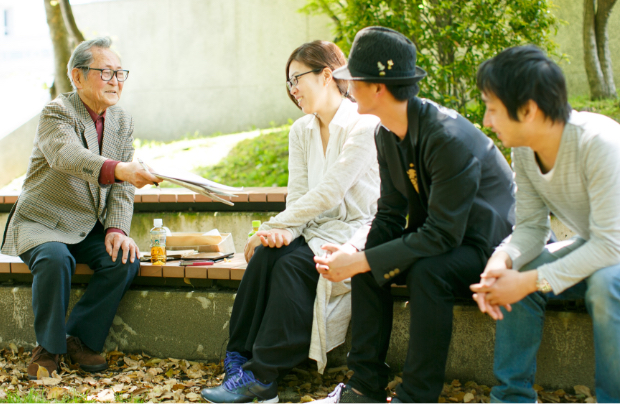
What are Hiroshima memory keepers feeling now, and what are they trying to pass on?
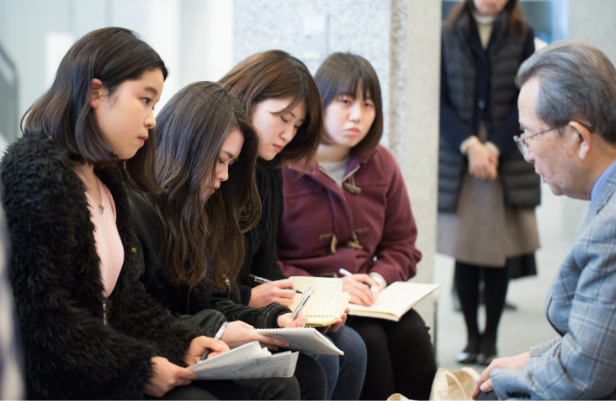
What can we learn from the bombing of Hiroshima? What messages can we convey to the next generation? Please share your ideas.
